Our asparagus patch is in full production. We’ve harvested at least ten pounds so far and if Jamie’s estimation is correct, we’ll pick another 20 pounds before the season ends! In addition to making asparagus pickles, we’ve also enjoyed it in the following ways:
- Brushed with olive oil, sprinkled with garlic powder and salt, then oven roasted (the omnivores in our home also love sprinkling it with parmesan or pecorino Romano cheese)
- Made into Easy Vegan Asparagus Risotto
- We’ve been chopping the raw spears and adding them to our daily garden salads
- Last night I sautéed it with Miyoko’s Vegan Butter, garlic, and fresh thyme
- We’ve made Grilled Asparagus, added it to Faux Chicken Salad (it was good!) and used it to make Potato Leek Soup with Asparagus (all three recipes are in my plant-based cookbook)
- And of course we’ve snacked on plenty of freshly picked raw spears
Before the season is over I’ll also freeze trayfuls single layer, and then vacuum seal the frozen spears in BPA-free bags (I have the FoodSaver’s base model v-2244). Frozen asparagus cooks up just fine.
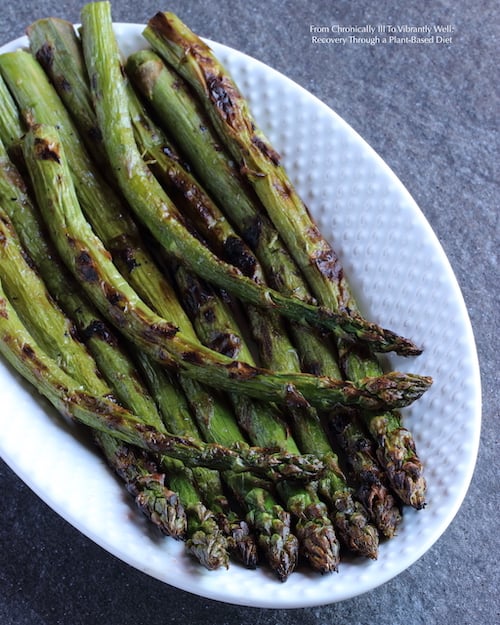
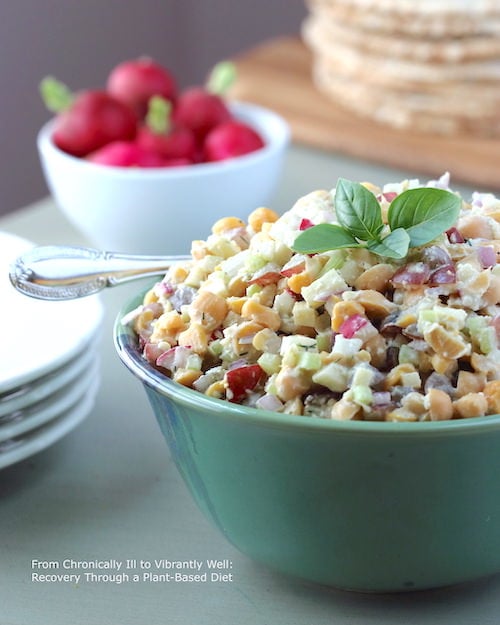
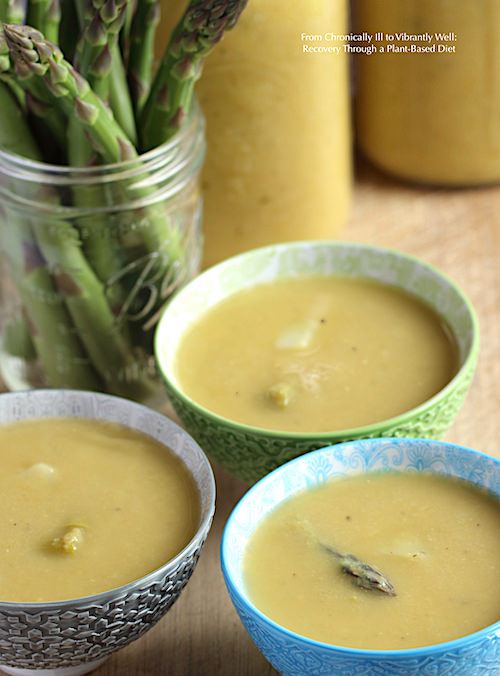
And for the first time ever, earlier this week, I canned jars of asparagus pickles! We opened a jar today to see how they came out, and I’m pleased to report that my husband, two of our adult kids, and mother all loved them! Oh and me too 🙂 I’m an old hand at making pickled beets, cucumber pickles, and pickled string beans – but this was the first time I pickled asparagus. Before I get further into that adventure, let’s take a step back and talk a bit about this amazing vegetable.
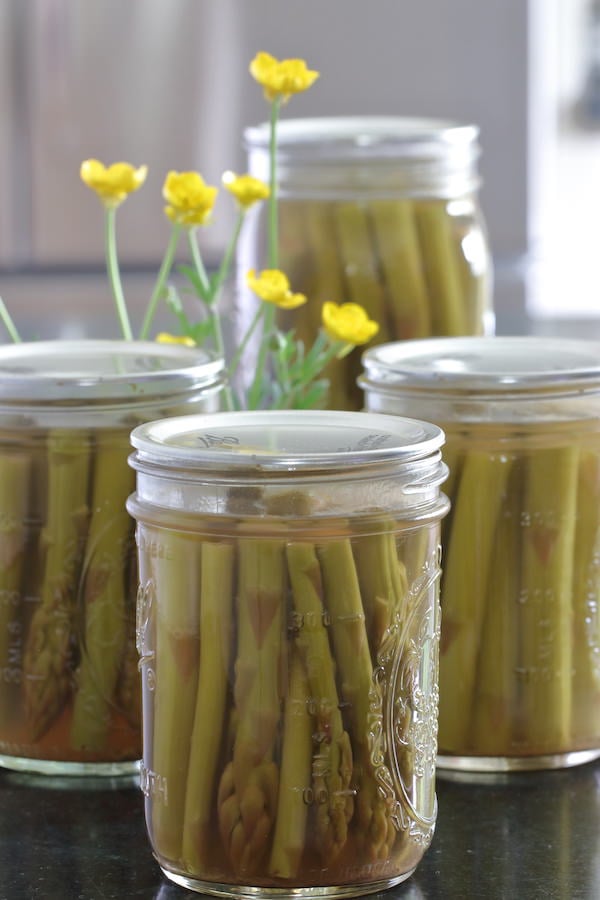
Asparagus is Such a Giving and Interesting Crop
- To start with, you only have to plant it once every 20 years. By the third season it starts to produce, and will continue to produce abundantly for decades!
- The spears begin to pop out of the soil in early spring and grow very quickly. In warm temperatures, they can grow up to six inches within 24 hours. A healthy patch will produce for several weeks.
- Light-green, lacy fronds develop and freely grow after the patch is done producing. This enchanting fern-like foliage grows up to six feet tall. Its purpose is to synthesize energy from the sun and then feed the underground root system. This process of storing energy is the reason why asparagus can produce for so many years.
- During the growing season all that is visible above ground is the asparagus itself standing at attention ready to be picked. It is so unlike any other vegetable that we grow in our gardens!
Some of the Nutritional Benefits
- Asparagus is high in folic acid and is a good source of potassium, fiber, vitamin B6, vitamin A, vitamin C, and thiamine
- It is packed with antioxidants and anti-inflammatory properties
- Researchers have found that asparagus (and other vegetables) have the potential to prevent and treat cardiovascular diseases
- According to the American Institute for Cancer Research, asparagus has anticancer properties
Let us now move on to the main topic at hand, namely how to make (and can) asparagus pickles
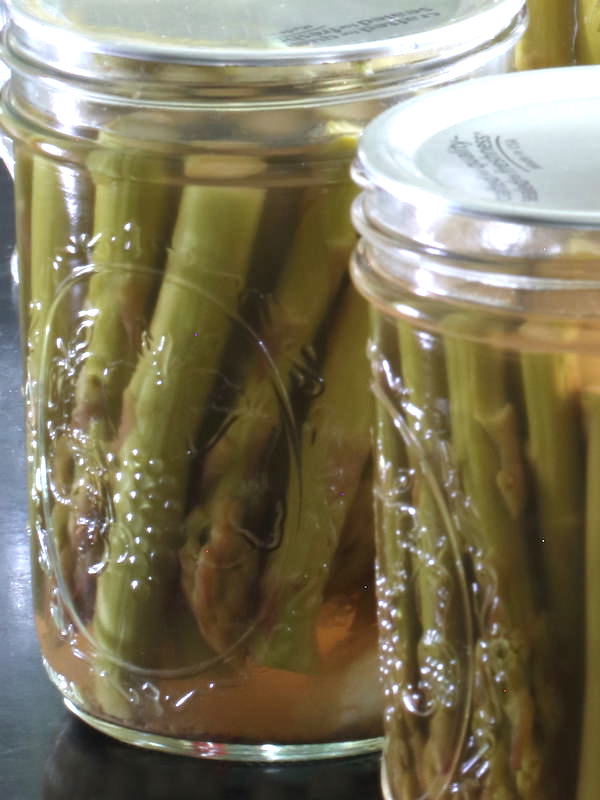
But first, what does the term “canning” mean?
Canning is a method of preserving food by processing and sealing it in an airtight container. Mason jars with two-piece lids are the recommended containers used for home canning.
Depending on the food being processed, either a boiling water bath or pressure canner (large pressure cooker) is required. Acidic foods such as pickles, tomatoes, and jams typically only require the use of a boiling water bath.
When canning I urge you to only use recipes that have been lab-tested by reputable sources such as the National Center for Home Food Preservation and university extension services. The Ball Blue Book of Preserving also has lab-tested recipes.
From Chronically Ill to Vibrantly Well: recovery through a plant-based diet
Pickling Asparagus
I followed the Pickling Asparagus recipe posted by Washington State University’s Extension Service. This recipe makes 8 pints or 4 quarts and requires the use of a boiling water bath to process the pickles. Once canned the jars are shelf stable; they should be kept in a cool and dark pantry and used within a year for best results.
Method Overview
- Cut asparagus to fit jars
- Heat up brine with salt and spices
- Put asparagus and garlic into hot jars
- Cover with boiling brine
- Process in boiling water bath
Reducing Salt and Substituting Spices
When I made this recipe, I reduced the salt dramatically from 6 Tablespoons down to 1 Tablespoon. Instead of using pickling spice, I used 1 teaspoon of dill seed. Master canners have explained to me that salt, spices, and herbs are allowable modifications when canning pickles since they are not required for the safety and preservation of the vegetables. Some may argue that reducing salt may effect the crispness and flavor; however, I always reduce the salt and haven’t had any issues. Please note that you cannot alter the amount of salt required by a recipe when fermenting pickles. Fermenting pickles is a different process entirely.
Acidity of Brine
The safety of canned pickled vegetables is dependent upon the acidity of the brine. The density of the vegetable being canned determines the acidity required. Researchers in test labs have figured out these details so we can safely preserve pickles for our families.
Pickled asparagus recipes call for brine that has a 50/50 ratio of water to vinegar (other vegetables, such as beets, require a more acidic ratio). The brine acidity can be strengthened by adding a higher ratio of vinegar, but never weakened with a higher ratio of water. White vinegar and apple cider vinegar, with at least 5% acidity, can be used interchangeably when pickling. The vinegar’s acidity is usually stated on the bottle. I prefer to use apple cider vinegar, but some folks prefer white vinegar since it is less apt to effect the color of the final product.
If you have a bumper crop of asparagus like we do I hope you’ll try your hand at making asparagus pickles. I only wish I tried making them years ago when we first started growing this crop. As it turns out, it’s a fairly easy way to preserve asparagus for the off-season – and it’s very delicious! Not only is it perfect eaten right out of the jar, it’s also wonderful when added to salads, wraps, and more.





No Comments